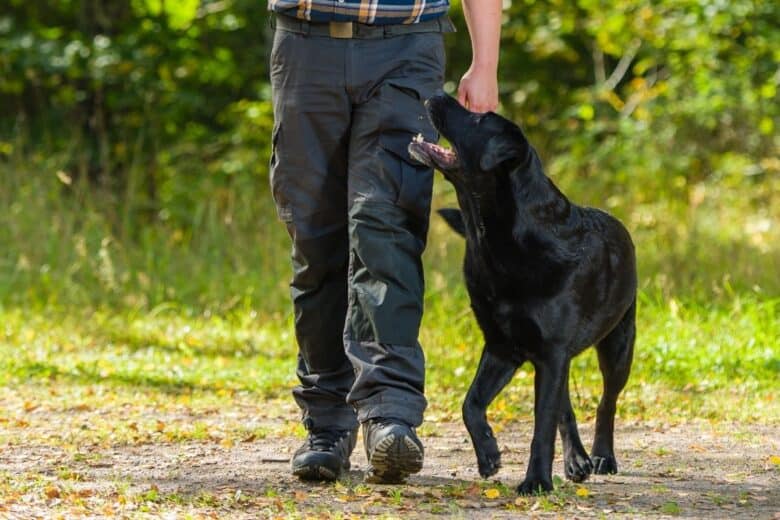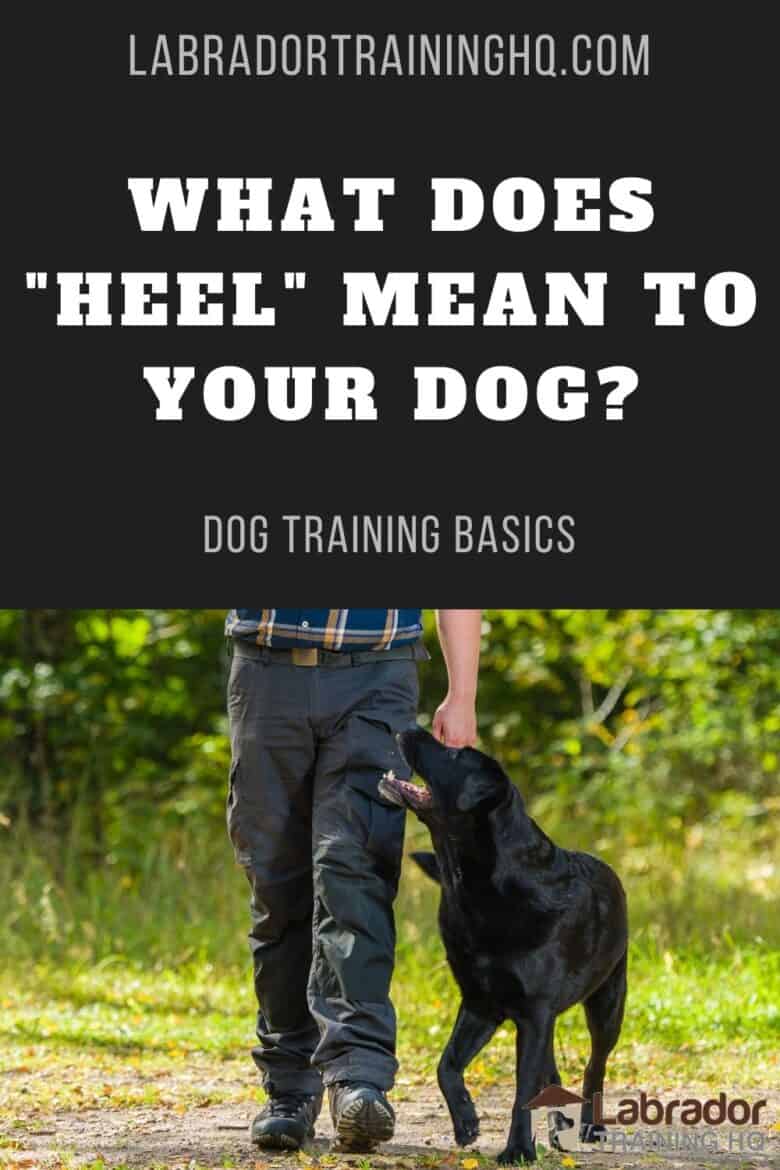This post may contain affiliate links. We may earn money or products from the companies mentioned in this post.
Heel means various things to different trainers. It also means different things depending on the dog’s purpose.
We’ve all seen an owner being dragged down the street by their dog. It’s unsafe and can end in the dog walker being injured.
Teaching a dog to heel on command will solve this.
Contents & Quick Navigation
Defining “Heel” In Dog Training
Heel is a position in which the area from the dog’s head to shoulder area is in line with the handler’s left hip.

Essentially, the dog’s neck area is aligned with the owner’s leg. Traditionally, the dog is on the person’s left side.
Some people think that the left side developed because hunters usually carried their guns in their right hands and held their dog’s leash in their left hand.
Consistency in which side you train the dog to walk on is important. Consider the following elements when training a dog to heel.
- Stationary or moving positioning. The dog must maintain the heel position whether standing, moving, or sitting.
- Distance from handler. The dog should be close to you when in heel position–about six inches away.
He should remain at that distance but not crowd the handler’s movement. The handler should always be free to move and the dog shouldn’t bump him.
Leash Position
The leash should be loose and never tight. But you don’t want it to be too loose enabling the dog to cross over back and forth.
I generally tell people to have a letter “J’ in the leash between them and the dog. The “J’ dangle in the leash ensures that the leash isn’t too tight or too loose.
What’s Your Purpose?
Teaching a dog to heel can mean different things depending on why you’re teaching the command.
- Regular walks. If you’re teaching the dog to stay next to you in heel for part of your regular walk, you don’t need him to stare up at you the whole time. In fact, it’s better not to teach him to constantly stare at you on your walk. The dog should have fun on his walk too! Dogs’ peripheral vision enables them to see you even if they’re not staring up at you.
- Working dog. Many trained dogs such as service dogs are trained to look ahead to see what’s in the environment for safety concerns. They have to see what traffic and other concerns lie ahead. Other working dogs, such as competition obedience dogs, are often trained to look up at the handler when in heel position.
I’ve shown many dogs in obedience. I train them to look up at me whenever they’re next to me–whether moving or not.
But I only use this attention heeling when training for the obedience ring and sporadically on walks.
I believe that dogs should enjoy their walks and learn to walk on a loose leash.
Why Teach a Dog To Heel?
There are many reasons to teach a dog to heel next to you. It helps teach a dog what’s expected of him.
Teaches impulse control
Teaching a dog to walk politely by your side teaches him to not be out of control.
If you teach him to heel in various places, you can count on him being well-behaved in many settings.
Heeling teaches your dog to be under control even when there are many distractions such as dogs walking by, children passing, and walking through crowds.
Teaches a dog not to pull on the leash
Having your dog right next to you can make for an easier walk.
You can also teach a “let’s go” command so that the dog walks on a loose leash but not in heel position
Provides physical and mental exercise
Positive training helps a dog learn. It helps his mind be able to learn more.
Both mental and physical exercise help to tire a dog out
Can help teach a dog how to walk off a leash
In order to have a dog walk well off a leash, it’s important to teach him the heel command.
Because heeling means staying next to you, if you teach him how to heel, you can have him walk off a leash in heel position.
Of course, this takes a lot of time and practice until you can trust a dog to behave off-leash
Can be used like an emergency recall
Because heel is a certain position aligned along your leg, you can teach a dog to get into that position.
I teach all my dogs to heel–from small dogs like shih tzus to large dogs like golden retrievers. I teach them that when I say “in heel,” they get into that position next to me.
Of course, it takes time to do this. But, eventually, they can even be across the yard and I give my “in heel” command, and the dog comes right next to me with their shoulders aligned with my left leg/hip area
Can be used to train a working dog
If you’re going to show a dog in American or United Kennel Club competitions, the dog needs to know how to heel on the left.
The last dog I’ve shown in competition is a rescued golden retriever named Riley.
Teaching him to heel with attention to me not only helped him achieve great scores but it also helped in everyday life. When I’d take him to the crowded pet store, he was able to remain next to me and calm.
How To Teach a Dog To Heel
There are many steps involved in teaching a dog to heel. As is true in any dog training, it’s important to set the dog up to succeed.
So, I like to have the dog physically exercised before teaching the heel command. Some fetching a toy should do the trick to take the edge off so that the dog’s not likely to pull.
In training, I’m assuming you’ll teach your dog to heel on your left side. If you choose to have him walk on your right side, just be consistent.
Always start without distractions. So it’s best to start heeling inside.
1. Teach some basic training exercises
A dog should know how to pay attention, sit, stay, hand target (“touch”), settle, and walk on a loose leash first.
Any control-type training exercises can help a dog learn how heel.
Use a reward marker like saying “yes!” to show what behavior is being rewarded.
Always have your reward treats ready. Use small, pea-sized treats that your dog likes. Cloud Star Tricky Trainers have small treats that are great for training.
2. Teach positioning
Have a dog sit next to you on your left side in heel position. Praise and reward.when he’s in the correct position.
Before adding motion, it’s important that your dog know where heel position is with his neck region aligned with your left hip/leg.
You can use a treat lure right above his nose to help get him into position. Then praise and treat!
Teach him to sit and to stand while in heel position. Even though dogs are used to sitting in front of us, they’re usually not used to sitting next to us.
Then, when you stop, your dog will learn to sit automatically if you practice it.
3. Teach attention on you while the dog’s sitting next to you
After you’ve taught your dog to pay attention while he’s in front of you, get him used to paying attention to you while he’s next to you.
To him, this is a different training exercise than watching you while he’s in front.
Say his name. When he looks at you, praise and reward. You can also add an attention cue like “look” or “watch.”
4. Add motion only after dog understands what heel position is
When adding motion, do so a little at a time. At first, say your dog’s name and “heel” and take one step forward.
Make sure that, before you move, you have the treat lure right above the dog’s nose.
When he moves with you, praise and immediately give him the treat as a reward.
Add steps as he’s able to heel correctly in place. Start by adding two steps, then three, and so forth.
When he can heel 20 steps well with you, you can start adding changes of direction and other cues.
5. Add attention to you when moving
As is true with all training, make sure that the dog is successful at each step before making things more difficult.
Use your dog’s name and tell him to look, then give the heel cue. Immediately start heeling. Praise and reward when he’s looking at you next to you.
Only take a step or two. Over training sessions, add more steps when he learns to heel with attention.
TRAINER TIPS: Be aware of the length of your stride. A small dog can only walk so fast naturally. So walk a shorter stride. Conversely, walk a longer stride for a larger dog.
Also be aware of your pace. Walk a normal pace at first while training. Once the dog understands what “heel” means, you can go faster and slower.
When I’m training Ralphie, my Lhasa apso, I make sure to take a small stride. But when training my golden Riley, I take a much larger stride.
It would be too much for Ralphie to try to keep up with the large stride I take with Riley. He’d have ro run to keep up.
6. Add a hand cue
Point to your left hip as a cue to help get your dog in heel position. You can then lure and reward him into position.
Eventually, you’ll be able to point to that area as a command for your dog to get in heel position.
7. Fade out the treat lure
Once your dog knows the positioning well, you can start to fade out the treat lure. Use it less and less frequently while teaching him to heel.
But still praise (“yes!”) and give him his treat reward when he’s heeled in position well.
8. Add turns to your heeling
After your dog heels wll in a straight line, start adding left turns, right turns, and about turns.
When first training turns, I’ve found it helpful to again use a treat lure just above the dog’s nose so that he can follow where he’s going.
Your dog will also read your body cues. So it helps in teaching position to slightly pull your shoulder back when doing a left turn. The dog has to get back and your body cue will help him.
When about to make a right turn, slightly pull your left shoulder forward as you turn. This will help the dog speed up around the turn to keep up with you.
When making an about-turn, you’re turning 180-degrees in the opposite direction. It helps to turn your shoulder sightly forward while doing the turn.
In each turn, then stand straight up and keep moving after the turn.
Always just start with a few steps after the turn. Then, after the dog understands the turns, you can walk further distances after the turn.
TRAINER TIP: Sometimes it helps to work on the turns without the dog at first, so that you get used to the motion.
It makes it easier to work with the dog when you don’t have to think about the turn and it becomes second nature.
9. Adding changes of pace
Once your dog understands how to heel when moving, you can start to teach changes of pace.
First, walk about 15 or 20 steps at a normal pace. You can then move a few steps a little more slowly. Praise and give a treat reward after a few slower steps.
During another training exercise, walk 15 or 20 normal pace steps, then move a few steps more quickly. Again, praise and reward when your dog keeps up in heel posiiton.
TRAINER TIP: It helps to practice changes of pace without the dog before training with the dog.
10. End training sessions on a positive note
After each training session, make sure the dog has FUN! Play a game such as fetch so that you end the training session on a positive note.
You want your canine companion to look forward to the next training session!
11. Add distractions when the dog’s able to handle them
Once your dog can heel with attention on you at various paces and with turns, it’s time to take it on the road.
Start practicing in your yard. Do short heeling sessions on your walk.
Proof your heel training in other settings. Go to a pet store and do a short heeling session.
You get the idea. As a rule, dogs don’t generalize well.
They need to learn that they’re expected to perform commands in real-life settings.
12. Keep training sessions short
We want our dogs to enjoy the training and be able to concentrate. Repetitive drills are boring. Most dogs tune us out.
When I’m training a dog who’s just learning to heel, I train for a few minutes. I’ll just do a few short heeling patterns and end when the dog’s successful.
13. When starting heel training, you can start off-leash inside
Then, add the leash while still training inside.
This assumes that the dog already knows basic commands of attention, sit, and loose leash walking.
TRAINER TIP: To teach a dog to heel with his body straight next to you, you can sometimes have him heel next to a wall with him between you and the wall.
Allow enough room that he can move freely but can’t swing out wide from you.
It’s great to teach dogs to heel. It gets control of your walk more than loose leashing walking can.
It’s especially important when you’re walking near other dogs or people or in confined spaces.
Save To Pinterest

Top Picks For Our Dogs
- BEST PUPPY TOY
We Like: Snuggle Puppy w/ Heart Beat & Heat Pack – Perfect for new puppies. We get all of our Service Dog pups a Snuggle Puppy. - BEST CHEW TOY
We Like: KONG Extreme – Great toy for heavy chewers like our Labrador Retrievers. - BEST DOG TREATS
We Like: Wellness Soft Puppy Bites – One of our favorite treats for training our service dog puppies. - BEST FRESH DOG FOOD
We Like: The Farmer’s Dog – A couple months ago we started feeding Raven fresh dog food and she loves it! Get 50% off your first order of The Farmer’s Dog.
For a list of all the supplies we get for our new service dog puppies check out our New Puppy Checklist on the PuppyInTraining.com blog.
What Does “Heel” Mean When Training Your Dog? was last modified: March 6th, 2021 by


